Life during COVID-19: Early findings report
Families in Australia Survey report
July 2020
Kelly Hand, Jennifer Baxter, Megan Carroll, Mikayla Budinski
Download Research report
Overview
The Life during COVID-19 survey ran from May 1 to June 9 2020 and had 7,306 participants from around Australia. It was the first survey in the Families in Australia Survey series.
Our aim was to understand how Australian families coped with the COVID-19 pandemic, one of the greatest health, social and economic challenges in history. We focussed on how families:
- adjusted to the pandemic, and the restrictions and programs that were put in place
- experienced the social and economic impacts of the pandemic
- supported each other, even when they didn't, or couldn't, live together
- protected their physical and mental health.
The findings in this report are drawn from our first analyses of the survey data. Later reports will add to, and expand on, these findings.
Key messages
-
The proportion of people always working from home rose from 7% before COVID-19 to 60% during it.
-
Before COVID-19, 30% of families used parent-only care. That rose to 64% of families during COVID-19.
-
While parents worked from home, 40% always or often 'actively' cared for children during work.
Felt like we got abandoned by work to sort out our own arrangements with little to no understanding of maintaining our productivity whilst having young children with us 24/7.
Male, 45, lives in a major city, household with children -
Almost half (43%) of respondents reported they or their partner had lost employment, reduced hours or wages. However 65% reported no real change to their personal income.
-
Young adults were disproportionately impacted by the economic downturn, being almost four times (15% vs 4%) more likely to ask for help from government or NGOs.
How we worked when we worked from home
Working from home and home schooling two children has been a huge burden, very difficult for us all. I struggle to complete activities sent by the school while working, and feel guilty and worried that my children aren't keeping up.
Female, 40, lives in a major city, household with children
The rise in work from home was arguably the biggest change to working patterns during the pandemic, when the proportion of people 'always' working from home rose from 7% to 60%.
Families with children under 18 years, where the parents remained employed during COVID-19, reported that 60% of mothers and 41% of fathers always worked from home. And at the same time, most school-aged children were learning from home. For parents working from home, that meant divided attention!
Two-fifths (40%) of parents who worked from home during the pandemic reported always or often 'actively' caring for children while working. Of the remainder, 28% reported always or often 'passively' caring for children, 21% reported sometimes 'actively' or 'passively' caring for children, and 11% said someone else looked after the children while they worked (typically the other parent).
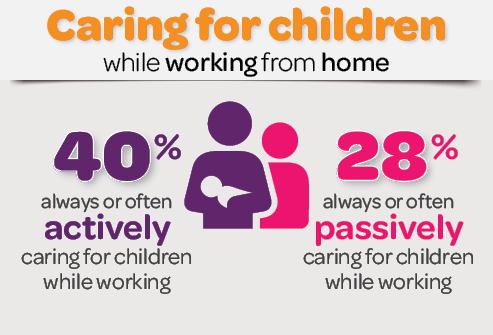
I asked to be stood down because I have had to support my three children with their remote schooling. My employer and I agreed I would stay on for one day per fortnight, on the JobKeeper subsidy.
Female, 45, lives in a regional area, household with children
The work day has extended substantially so that I can fit in home schooling. Teaching takes up time when I should be working so I have to make up the work hours when the children have gone to bed. The children also have to have something to do when I have virtual meetings which can be quite challenging and they can become restless if the meeting is long.
Female, 39, lives in a major city, household with children
How we cared for our children
On April 6 2020, the Child Care Relief Package came into effect, providing free child care to families (with priority for essential workers and vulnerable children). Despite this, the survey recorded a steep drop in approved care usage and all other forms of non-parental care:
- 52% used approved care before COVID-19, and 26% during
- 32% used grandparent or other informal care before, and 9% during
- 8% used nannies or babysitters before, and 5% during.
While 30% of families used parent-only care before COVID-19, 64% used it during. And hardly anyone (1%) started using approved care during COVID-19; the same for other forms of non-parental care.
Figure 1: Care arrangements for children under 13 years, by age of youngest child, before COVID-19 and during COVID-19

Source: Families in Australia: Life during COVID-19, final dataset. CC BY 4.0, Australian Institute of Family Studies (AIFS)
Grandparent care
Grandparent care was a casualty of the pandemic. Nearly three out of 10 grandparents told us they provided child care at least weekly before COVID-19. Some grandparents said nothing had changed and they were still helping out, but most told us that during COVID-19 they ceased providing care.
I no longer see my only grandchild at all. He is 3 years old. I cannot help my daughter and son-in-law at all, because of the border closure between NSW and Queensland.
Female, 69, lives in a regional area, single-adult household
Still see the youngest [grandchildren]. They live in a two-bedroom unit. For my kid's mental health I still supported them. The older ones are school age and their father had to work from home. We didn't see them as much.
Female, 67 (grandparent), lives in a regional area, couple-only household
Gendered care
Did all the changes to work affect the way mothers and fathers shared child-care responsibilities?
When asked 'Who typically cared for the children?' before COVID-19, parents answered:
- 'always or usually' the mother 54%
- equally between mother and father 38%
- always or usually the father 8%.
When asked 'Who typically cares for the children?' during COVID-19, parents answered:
- 'always or usually' the mother 52%
- equally between mother and father 37%
- always or usually the father 11%.
These changes are very slight. However one cohort stands out: parents of children under 3 years old. In this cohort, equal sharing increased from 28% to 37%, and care 'always or usually' by the mother decreased from 63% to 56%. That said, it was still rare for fathers in these families to take the primary caring role (stable at around 10%).
My husband has always gotten involved in house work and childcare but as the demands of my work increased and he needed to step up to care for our child while I was on video conferences or meetings, he was quite concerned about his unequal share of care responsibilities even though it was only temporary. It was as if he just discovered I have a real job.
Female, 41, lives in a major city, household with children
How we did the housework
What about doing the shopping, cleaning and cooking? Among couples with and without children, before COVID-19 the female partner typically did the lion's share. This barely changed during COVID-19.
Nothing much has changed. However the load has significantly increased because we are all at home and the children particularly the preschooler is chaotic mess maker. We have retained the cleaners once a fortnight.
Female, 40, lives in a major city, household with children
Although my partner stepped up to help with home schooling and domestic duties at the start of the pandemic, it wasn't long before it shifted to inequality again.
Female, 40, lives in a major city, household with children
I am cooking a little more, but it's mostly the same.
Male, 57, lives in a major city, multiple-adult household, no children

How we worked, or not
A tale of two cohorts
During the pandemic, work hours and income fell overall. Almost half of respondents (43%) reported they or their partner had lost employment, reduced hours or wages. A majority (65%) reported no significant change in their personal income. Not so for young people. The pandemic was bad for small businesses and job security, but especially so for under-30s.
- Just under 10% of participants said they'd been stood down, made redundant, or lost their job or their business during COVID-19.
- However 21% of under-30s said they'd been stood down, made redundant, or lost their job or their business during COVID-19.
Changes to employment and income
As reported above, most participants (65%) reported no real change to income during COVID-19. Meanwhile, a quarter (25%) reported a small or large decrease and 8% reported an increase.
We appear to save money as we are not paying for [before-and-after-school] care, swimming sessions and going out.
Female, 52, lives in a major city, household with children
People under 30, though, were more affected: 30% reported a decrease and 15% reported an increase.
I am having to be extremely cautious of what I spend and help out more than usual with finances around the home. I fear that I'll never be able to own my own home, not even in partnership with someone.
Female, 20, lives in a major city, multiple-adult household, no children

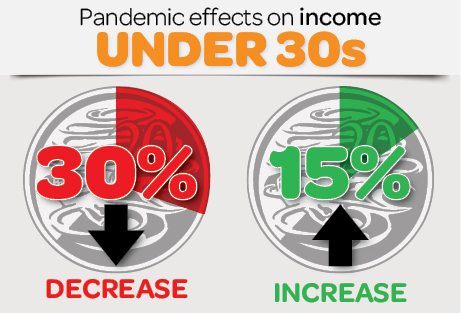
Changes to living arrangements
Under 30s were most affected by changes to work during COVID-19. They are also the least likely cohort to own their home. So it's not surprising that 21% reported changes to their living arrangements during the pandemic. Many said they had moved back with their parents, which explains why 21% of 50-59 year-olds also reported a change: the kids had moved back in!
My partner and I were living overseas at the start of the outbreak and would normally live with other adults in a share house. However, we didn't have a residence in Australia when we returned early so we moved in with his family.
Female, 28, lives in a major city, household with children
Figure 2: Percentage reporting who they live with has changed, by age group
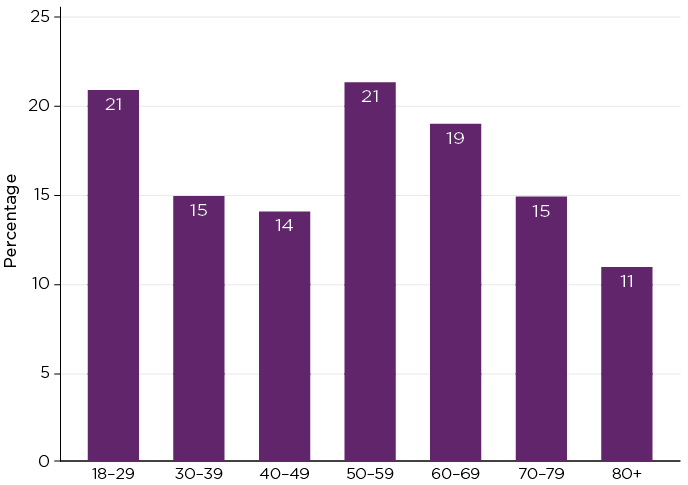
Source: Families in Australia Survey: Life during COVID-19, final dataset. CC BY 4.0, Australian Institute of Family Studies (AIFS)
Getting by with a little help
Many young people relied on family support during the pandemic, including direct financial support. People aged 18 to 29 were three times (21% vs 7%) more likely than others to have asked for financial support from friends or family during COVID-19. And they were almost four times (15% vs 4%) more likely than others to ask for help from government or NGOs.
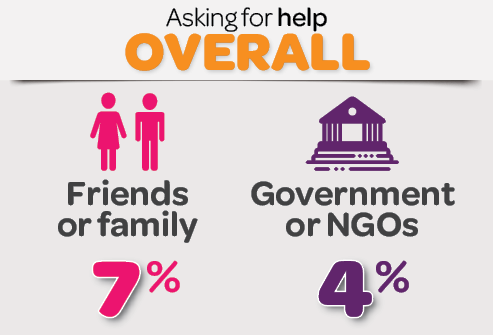

We financially assist our son and daughter, who are both currently unemployed due to previously being casually employed.
Female, 58, lives in a major city, multiple adult household, no children
What we missed most
We asked our participants if there was anything that they especially missed during the COVID-19 restrictions, or 'iso'. This is what they told us.
Figure 3: Wordmap of things we missed during 'iso'

Source: Families in Australia Survey: Life during COVID-19, final dataset. CC BY 4.0, Australian Institute of Family Studies (AIFS)
About the survey
Life during COVID-19 was the first survey in the Families in Australia Survey (AIFS' flagship survey series). It ran from May 1 to June 9 2020, during the COVID-19 (coronavirus) pandemic.
The pandemic in Australia triggered an unprecedented set of government responses, including the closing of Australia's borders to non-residents, and restrictions on movement, gatherings and 'non-essential' services. See Pandemic timeline, below.
Figure 4: Pandemic timeline
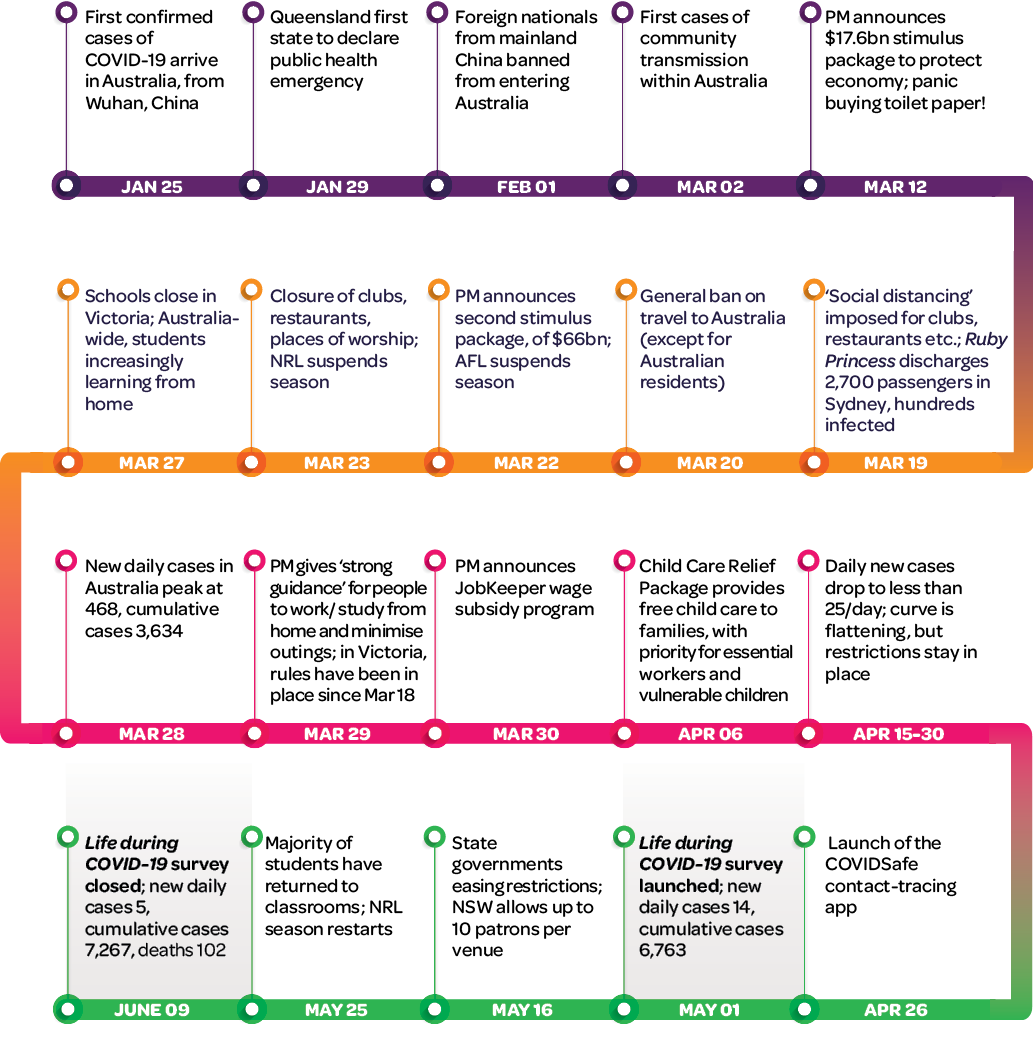
Note: CC BY 4.0, Australian Institute of Family Studies (AIFS)
Although the health consequences over the period were not as severe in Australia as they were in many countries 1, social and economic effects were profound. The Life during COVID-19 survey, undertaken during the pandemic, attempted to capture some of those effects. The survey was promoted through the media, social media, newsletters, internet advertising and word of mouth. Response was overwhelming (see below).
Survey participants
There were 7,306 respondents to the survey, of which 6,435 completed all survey questions.
| Sample characteristics | % |
|---|---|
| Female | 81 |
| Male | 18 |
| Other/prefer not to say | 1 |
| 18-39 years old | 26 |
| 40-59 years old | 41 |
| 60+ years old | 33 |
| Bachelor degree or higher | 62 |
| Aboriginal or Torres Strait Islander | 2 |
| Single person households | 14 |
| Multiple adult household (no children) | 20 |
| Couple-only households | 27 |
| Household with children | 39 |
Note: Compared to the general population, the survey sample over-represents: females, middle-aged, tertiary educated,
coupled (with/without children).
Every state and territory was represented, with Victoria, the ACT and Tasmania over-represented. By geo-graphical area, 57% resided in a major city, 40% in regional Australia and 3% in remote or very remote Australia.
Authors: Kelly Hand, Jennifer Baxter, Megan Carroll, Mikayla Budinski
Editor: Michael Day
Graphic design: Lisa Carroll
Contact
For more information, visit the Families in Australia Survey project page or email [email protected].
Featured image: GettyImages/golero
Hand, K., Baxter, J., Carroll, M., & Budinski, M. (2020). Life during COVID-19: Early findings. (Families in Australia Survey report). Melbourne: Australian Institute of Family Studies.